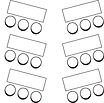
MÖTESMÖBLERING
Möbleringen i mötesrummet har en avgörande betydelse hur ni kan få ut maximalt av mötet beroende på vilka mål ni har.
Här har vi samlat de vanligaste mötesmöbleringarna och vilka sittningar som passar bäst. Fråga gärna oss om du undrar över något.
Tips!
-
Bord skapar ofta hinder mellan deltagarna.
-
Möblera om under dagen! Det skapar ny energi i rummet och även nya möten mellan deltagarna.
-
Placera några ståbord längst bak i rummet. På så sätt kan deltagarna variera mellan att stå och sitta. Särskilt bra för deltagare med ryggproblem.
-
Ta bort mötesledarens bord/kateder längst fram. Ställ dit ett ståbord istället om hen behöver ha material nära till hands.
Biosittning
Passar större grupper där fokus ligger på mötesledaren, framför allt vid informationsmöten där interaktivitet inte är en viktig del.
Fördelar: Många får plats i mötesrummet.
Nackdelar: Är gruppen för stor (över 100 personer) är det svårt att se mötesledaren utan en scen.
Fiskben
En bättre variant av skolsittning där borden och stolarna är snedställda.
Fördelar: Deltagarna ser mer av varandra.
Nackdelar: Bord skapar hinder vilket minskar den kreativa effekten.
Skolsittning
Den mest klassiska sittningen. Passar för grupper om ca 20-35 personer, vid föreläsning och utbildning där deltagarna ska kunna föra anteckningar.
Fördelar: Lätt att ta anteckningar.
Nackdelar: Interaktionen mellan deltagarna minskar, då man inte ser alla och många sitter med ryggen mot de andra deltagarna.
Stolar i ring
Passar bra vid möten där man ska göra utvärderingar eller vid laget-runt-övningar. Ett alternativt till styrelsesittning som skapar mer kreativitet. Stolarna kan även placeras som ett u.
Fördelar: Skapar delaktighet - alla ser alla.
Nackdelar: Passar inte större grupper då man kommer långt ifrån varandra. Svårt att föra anteckningar.
Styrelsesittning
Här fattar ni beslut i mindre grupp.
Styrelsesittning passar bäst när ni är max 12-16 personer och ska diskutera samt ta beslut.
Fördelar: Alla kommer nära varandra och det är lätt att ta anteckningar och att använda sin dator.
Nackdelar: Passar mindre bra om ni är fler än 16 personer eftersom ni kommer långt i från varandra.
U-bord
Passar bra för föredrag eller utbildningar med diskussioner mellan mötesdeltagare och mötesledare, eller mellan mötesdeltagarna. Cirka 12-25 personer.
Fördelar: Alla ser alla och mötesledaren kan enkelt komma nära mötesdeltagarna. Enkelt att göra anteckningar.
Nackdelar: En stor del av deltagarna får sitta snett mot presentationsytan.
Öar
Öar passar bra till arbetsmöten där man varvar grupparbeten med att ge information till deltagarna, och där anteckningar behöver föras.
Öarna kan vara rektangulära eller runda.
Fördelar: Inbjuder till delaktighet och diskussioner i mindre grupper och ni behöver inte sprida ut er på samma sätt på anläggningen för att arbeta i grupper.
Nackdelar: Tar mycket plats, så mötesrummen begränsas. Några kan eventuellt få sitta med ryggen mot mötesledaren.
Walk and talk
Ingen sittning men en jättebra mötesform för mindre möten där kreativiteten ökar. Ta med er några frågeställningar och gå ut på en promenad under en förutbestämd tid.
Fördelar: Ni behöver inget mötesrum och får frisk luft på köpet.
Nackdelar: Det kan vara svårt att föra anteckningar. Tips! Spela in vad ni säger med hjälp av en smartphone.











